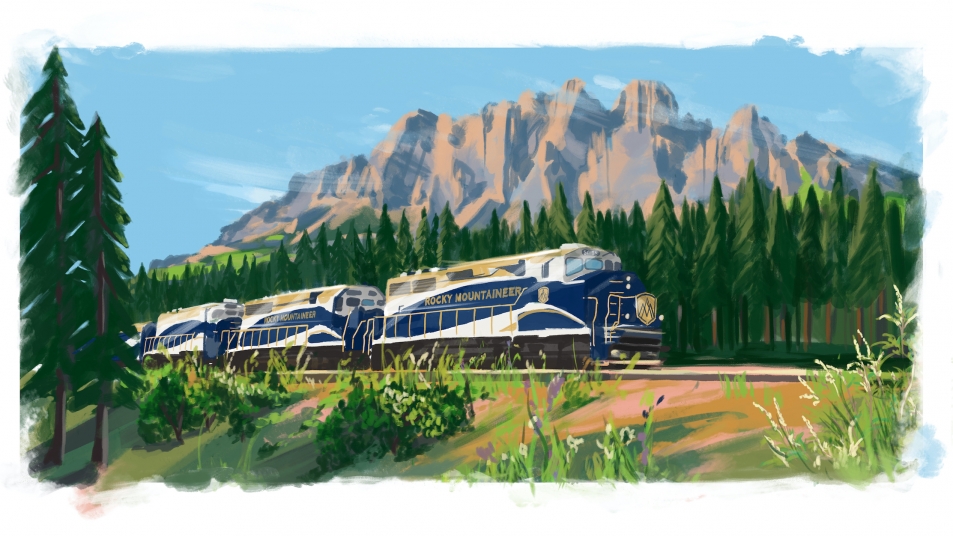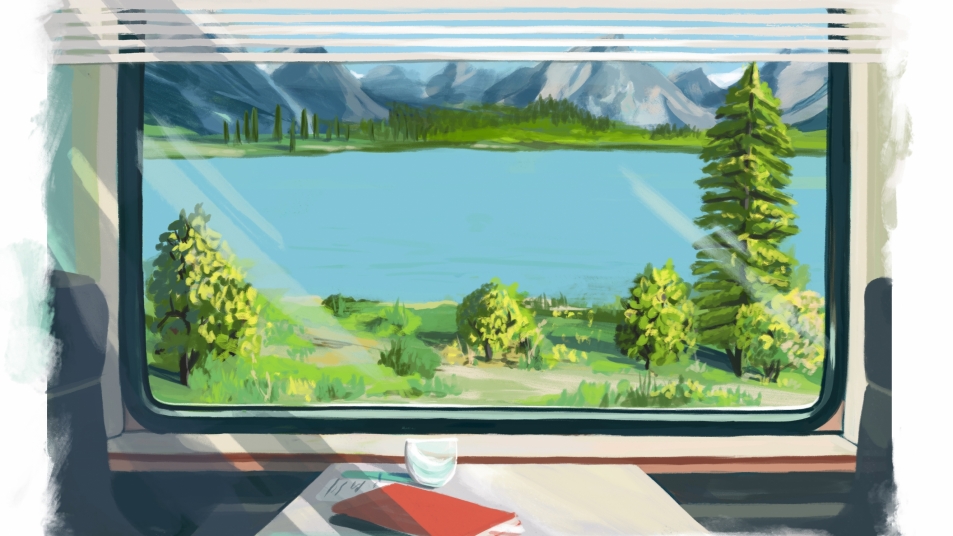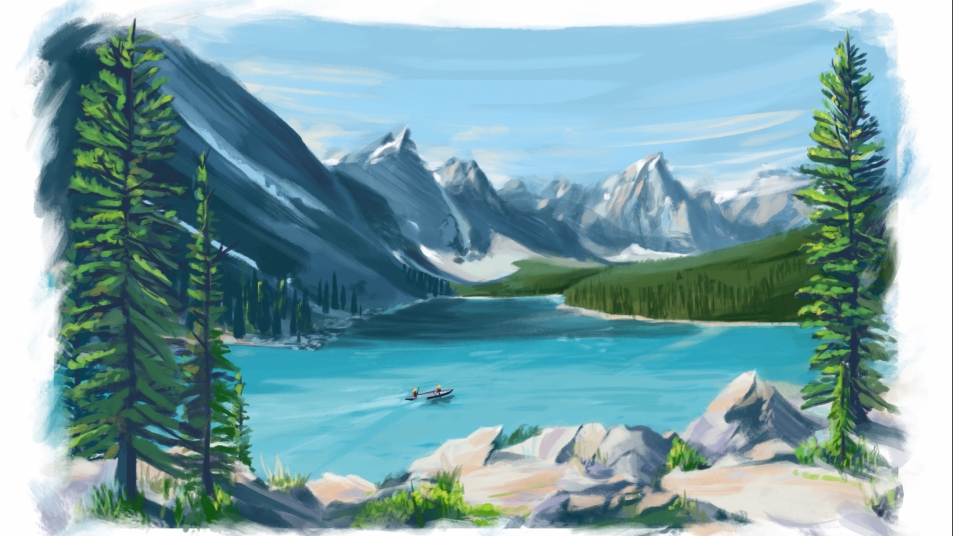
Apparently, my travelling companion thought that the bears would be coming in on parachutes. That’s the impression I’m getting from the way that she frantically searches the sky as the train trundles past a black bear standing in plain sight by the side of the tracks.
We are on board Rocky Mountaineer as it winds its way through the mountains of British Columbia, and, though I am Canadian and thus, almost by definition, a rugged outdoorsman at heart, my companion, through no fault of her own, is Not Canadian. She is, in fact, from New York, a city known for wildlife, though not of the ursine variety.
“Don’t look up,” I advise. “Look down.” It’s the sort of wilderness acumen that we Canucks are born with.
We are seated like Gilded Age heirs on the upper floor of a luxury train coach, under glass-dome windows that offer sweeping views of forest and valley. Any bears down there, we’ll spot ’em. It’s just a matter of time. And time is what you have on the train’s First Passage to the West route, a two-day journey from the Pacific Coast, over the Continental Divide, and to the resort town of Banff, high among the Rockies. This is travel as it was meant to be, a throwback to more languid days.
We left Vancouver in the early morning, a kilted bagpiper playing us off. (Rocky Mountaineer has its own tartan: blue and yellow, sky and sun, duly registered in Scotland.) The train began to move, almost imperceptibly, and slowly picked up speed, rolling into Canada’s wild heart, following the historic route of the Canadian Pacific Railway.
Mist on cold mountains. Forests feathered in green. Arching iron bridges. Piers standing in their own reflections. We pass Fort Langley, “birthplace of British Columbia,” where the crown colony was first proclaimed, in 1858, largely as a way of blocking the United States’ expansion north during a gold-rush stampede. Canada’s entire western coast, from Seattle to the Alaska Panhandle, might now be American territory were it not for that proclamation. Even then, the colony of British Columbia remained in a precarious position until the railway finally secured its place in a larger confederation. Trains made modern Canada.
Other, older histories are here as well, and soon after Fort Langley we pass the X̲á:ytem Longhouse Interpretive Centre, built on an ancient First Nations site that is the oldest known dwelling place in the province—and one of the oldest in North America, dating back approximately five thousand years. The weathered cedar building flits past; beyond it are the grassy knolls of the archeological site and a sacred boulder, the Stó:lō transformation rock, which is said to sing and cry.

The landscape begins to close in as we continue deeper into the Fraser Valley: dark evergreens and trembling aspen, jazz hands fluttering gold and green. The train races alongside a fast-running river in the cleft below, and, not content to gaze through the glass at the swirling currents and fern-festooned cliffs, passengers congregate on the outdoor viewing platforms between the coaches. Here, you can step from the genteel quiet into a blast of fierce wind, invigorating and unexpected. We shout to be heard, grinning and wind-raw; it’s a reminder that, coziness aside, we are indeed cruising across the wild.
Below us is Hell’s Gate, notorious rapids that thwarted early attempts at navigation and drowned many a pathfinder. We are on the lookout for camels. In the eighteen-hundreds, on a wagon trail into the Cariboo gold region, one enterprising chap imported the shaggy ungulates, predicting that they’d be perfect pack animals. Alas, their soft feet and habit of spooking horses eventually saw them released into the wild. If the mythical Sasquatch can exist in these forests, perhaps a few rogue camels remain as well?
More than two hundred feet in the air, a high bridge leaps across the water at Cisco Crossing, near the confluence of the Thompson and Fraser rivers. But, instead of merging immediately, the rivers run alongside each other, one silty, the other clear, for almost two miles before finally blending. The rapids we skirt have names that stir the blood: Witches Cauldron, Devil’s Kitchen—and, less impressive, Tadpole. Soon after, a frisson of excitement ripples down the train: “A bear! On the left!”
As guests scramble across to see, my travel companion scans the skies again for incoming bruins. When she realizes that she has missed the (painfully conspicuous) black bear poised 10 feet from the tracks, she sinks into a funk. “I want to see a bear,” she says firmly. It is her one overriding goal.
It isn’t only the guests who get excited. “Sometimes I think we’re worse,” Samantha Lamothe says. Sam is one of Rocky Mountaineer’s on-board hosts, and she tells me that seeing bears so close by is “like Christmas morning every time.”
As a fellow-Canadian, I’m a little embarrassed for her. It’s unseemly to get excited over bears. We Canadians are constantly beset by them. We often have to brush black bears off our cars before we can drive to work in the morning. To be honest, though, I’ve never seen a grizzly bear, not in the wild. This is what I secretly want, though I would never admit it: to see a grizzly staggering out of hibernation. And, yes, Sam has seen them—just the previous week, in fact.

The view begins to open up, revealing an arid stretch of rounded hills and eerie stone formations. Ghosts abound in this inland desert. A cluster of abandoned homesteads and a scattering of bighorn sheep are all that remain of the once glorious Walhachin, an outpost of upper-crust Brits, complete with elegant hotels and lavish manors. “It was pretty much the Downton Abbey of its time,” Sam says as we roll through the emptiness.
But the call of Empire reached this remote expat community long ago, and very few of Walhachin’s young men came back from the Great War. The town sank into moldering nostalgia, the polo fields were overgrown, and the current population stands below forty.
Now Rocky Mountaineer is fast approaching what is, quite literally, the center of the universe. I do not use that phrase lightly. In the nineteen-eighties, a Tibetan monk appeared in Deadman Valley, northwest of the city of Kamloops, explaining that esoteric calculations had revealed this to be the very center of the cosmos and that he had been sent to negotiate a transfer of land. Unfortunately, a visit from the Dalai Lama fell through, and the monk eventually departed empty-handed.
Kamloops, in the heart of ranching country, also marks the end of our first day on the tracks, and the train’s arrival is heralded by members of the town’s mounted patrol, astride their steeds. After a day of cradle-rocking motion, our legs are a little spongy and our balance is slightly off-kilter as we head to our hotel for the night.
“It’s called train legs,” Sam explains. “But don’t worry, it generally wears off after two or three weeks.” I think that she’s joking.
The next morning, there are rumors of snow in the mountains ahead, and the Australians in the group are getting excited. In Canada, we rarely get excited about snow. Poutine, perhaps. Hockey, certainly. But snow? Our New Yorker, meanwhile, is still waiting for the bears to show up. “There was one in the hotel lobby, just this morning,” I say. “You didn’t see it?”
We dine on eggs Benedict and field-berry parfait as the hoodoos and mesas roll past. Passengers are served a full breakfast and a three-course lunch on board, impeccably prepared by a fleet of in-train chefs.
I can’t even whip up a proper hollandaise at home, and my kitchen is more or less stationary, depending on how much of the cooking sherry I’ve been sampling. I seek out Daniel Stierhof, an executive chef on Rocky Mountaineer, to ask about his brand of fast-moving fine dining.
“Oh, it’s a challenge, all right,” he tells me over a cup of coffee. “You’re constantly in motion. You can only fill saucepans halfway, have to keep your balance when slicing vegetables.” The train’s kitchen has safety guards to keep drawers from slamming open on quick curves, but chefs eagerly await moments of stillness. “When the train stops or pulls over, onto a siding, the kitchens begin to fly,” Daniel says with a laugh. “Everyone starts chopping, slicing, sautéing like mad.”

Rocky Mountaineer’s menu is locally sourced whenever possible, from farms and communities along the route: squash and other root vegetables, local dairy and cheese, and, of course, British Columbia’s world-renowned salmon. The way that Daniel uses those ingredients depends, in part, on the possibilities for plating and presentation. “We do a shake test on all new dishes,” he explains. Hence the selection of thick, creamy soups, rather than sloshy broth-based ones. Daniel sips his coffee and grins at the landscape beyond the domed windows. “Not a bad place to have an office, right?”
The train rolls on. Was there ever a more beautiful sentence? On Shuswap Lake, seaplanes float, tethered atop a mirror of water. I join Mikala Folb on the outdoor platform, against a backdrop of snow-dusted peaks. She’s been with Rocky Mountaineer’s marketing team for two and a half years, and has taken this trip a half-dozen times. It never gets old. “I’m a city kid,” Mikala says. “Most of us don’t really connect to small communities anymore.” She looks around at the gleaming coaches. “People get excited when we pass. Parents holding up a child so they can see the train. People running out of their home to the end of the drive to wave.” One such fan, Mikala tells me, is Doris, who greets the train each time it passes her yellow house, near the town of Canoe. Rocky Mountaineer staff became so fond of Doris’s big, joyful waves that they eventually invited her on board for the trip. Sure enough, there she is now, standing on her back porch, blowing kisses and waving wide at us as though signalling a passing ship. Mikala and I shout back our greetings as Doris in the yellow house slips into the distance.

Coming into Revelstoke, we pass Craigellachie, where, in 1885, the final spike of the Canadian Pacific Railway was driven home, binding Canada from sea to sea. By this point, though, I have retreated from the wind into the warm comfort of a glass-domed luxury coach, where I toast that historic last spike with a glass of Chardonnay.
And that’s when we see it, posed like a photograph in a wildlife calendar: a young black bear beside a mountain stream, looking up at us. Soon after, two more, back to back. My fellow-traveller from New York squeals. I, of course, maintain my usual sang-froid.
At Revelstoke, we have reached the Columbia, one of North America’s great riverways, and the water is a startling aquamarine, tinted by rock flour, a silken powder from glacial erosion. On the other side of the river, the Rockies appear like an Ansel Adams picture, pushing their sheer mass upward, snow-encrusted and stark, almost monochromatic.
Before the end of our journey, we must thread the needle. We have come at last to the Spiral Tunnels, an engineering marvel made even more remarkable by the fact that these corkscrew passages were blasted out of the stone more than a century ago.
At the town of Field, the grade was so steep that locomotives routinely derailed. The railway needed to somehow blast a long passage through a short mountain. The solution was to twist the tunnel inside the earth, not once but twice. The Spiral Tunnels form an elongated figure eight, turning inside two separate mountains, Ogden and Cathedral. We come out of the rock looking down at the tunnel entrance that we just went through, a dizzying moment. Rocky Mountaineer is the only passenger train that takes this route, but long freight trains can be seen emerging from the upper tunnel while their rear cars are still entering at a right angle below—an Escher sketch come to life.
It’s winter on this side of the mountains, the Australians are exultant, and I feel enchanted. Great storybook flakes waft down, blanketing the fir trees. We have crossed the Continental Divide, marked with a stone cairn and a sigh, and are now on our way down toward Lake Louise and, beyond that, Banff itself. And then . . .
Shoulders rolling, breath puffing, that distinct hump and rump, laboriously making its way up a low slope: a lone grizzly. In the wild.
I squeal.


